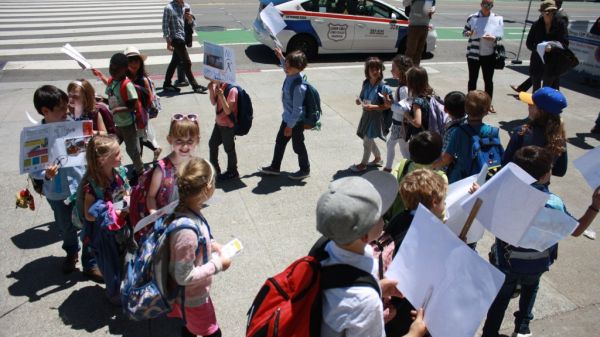Student Action at Any Age

“Most first graders don’t get to go to City Hall, do they?” quipped one of my first grade students. She was referring to our field trip the day before to San Francisco City Hall, where our class of nineteen 7-and 8-year-olds successfully lobbied our elected officials to ban plastic straws in San Francisco. The trip was the culmination of our year-long journey towards becoming Giraffe Heroes, brave and caring people who stick their necks out for others and don’t give up even when it’s hard or scary. In other words, they were learning how to be activists.
Student activism is a hot topic at the moment, thanks in large part to the international spotlight on brave young people like Greta Thunberg and many other youth climate activists. But how exactly does one become an activist? What if you’re shy? What if you’re only in first grade? Can you really make a difference? I certainly don’t profess to have all the answers, but I do have my own experiences as a teacher helping my students find their inner activist. Here is what I have learned.
1. Connect the action to issues THEY care about. A common stumbling block for teachers hoping to turn their students into activists is apathy or lack of investment on the students’ part. I think we can all agree there’s nothing worse than trying to force students to care about an issue about which they are unmoved. The solution? Let the students choose the issue. Sometimes issues arise organically based on current events, and sometimes the process is more intentional and involves lots of brainstorming and discussion. It’s unlikely that you’ll find an issue about which all of your students are equally passionate, but, by using some of your teacher-magic-finesse, you can usually find a way to combine ideas and settle on an issue that the majority of your class will buy into.
2. Be the guide on the side, not the sage on the stage. Handing over the reins to students dramatically increases their levels of investment and engagement in any project. Keep their ideas and interests front and center throughout all stages of your project, and let them do the majority of the work. As the teacher, your role is to provide structure and parameters within which the students can be creative and generative, and to help them refine their vision to something that is actually possible and doable. For example, my students wanted to attend a Board of Supervisors meeting and speak during the public comment portion, but once we learned that the meetings started at 7pm and typically lasted 4-5 hours, I helped them refine that goal to asking for a meeting with one Supervisor instead. They will likely need your help with working out some of the nitty gritty logistics of whatever action they decide to take, but leave the big-picture planning and vision-setting to the kids. As an added bonus, keeping the project kid-focused goes a long way towards getting parent buy-in (and reducing push-back). Which brings me to…
3. Invite families to participate. Another common barrier for teachers hoping to bring out the inner activist in their students is resistance from parents and guardians. Sometimes families don’t agree with the cause the students have chosen, and sometimes they are concerned about risk and student safety. I find that inviting families to join in the process alongside students is very effective and helps ease their minds. I have a suspicion that much of the push-back stems from fear of the unknown, so I try to make our process as transparent as possible for all involved. For example, I invited all families to join my students in their rally at City Hall. A good number of parents and siblings showed up, and once they saw how excited and engaged their children were, they soon picked up signs of their own and joined in chanting, “Go away plastic straws!” Additionally, when families know that the project is based on students’ own ideas, and not imposed from above, they tend to be much more open-minded.
4. Talk about activism early and often. In my classroom, activism is a lens through which I plan all my other curriculum. It is not a discrete unit or subject, but rather I do my best to infuse it into my lessons and activities throughout the year. For example, each year my students participate in a project-based learning unit called Adapt Your Hobbies where they learn about physical disabilities and then use the design engineering process to build an adaptation for one of their favorite hobbies so someone with a physical disability could participate in the hobby. This year, one group created a prosthetic arm with a special hook at the end to allow someone without an arm to rock climb. Throughout the year I share examples of activists of all types and forms through read alouds, videos, current events, and more. I especially try to provide examples of activists my students can relate to, such as other young children. We spend the year laying the groundwork for how to be an activist so that when spring comes around, my students are ready to engage in direct social action on a larger scale.
5. Leverage resources. I have finally learned after almost ten years in the classroom that asking for help is not a sign of weakness. Rather, it is the sign of a good teacher! I lean heavily on resources like Giraffe Heroes Project and Teaching Tolerance, as well as individual people with whom I have built relationships. For example, a parent of one of my students had connections to City Hall, and she was able to use those connections to set up meetings for my students with both a Supervisor and the Mayor, a feat which otherwise would have been extremely challenging if not impossible. At the risk of sounding trite and cliche, we truly are stronger together, and reinventing the wheel does not make you smart– it just makes you tired.

Comments
Dear Natalie,
Great what you've been doing and encouraging students to be activists. It is really worth learning! Thank you for sharing. Best, HA